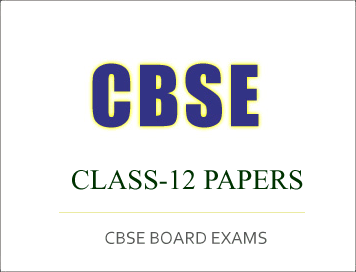CBSE Class-12 Question Papers for IOP/Comptt Examination 2017 : All India Scheme, Entrepreneurship
Disclaimer: This website is NOT associated with CBSE, for official website of CBSE visit - www.cbse.gov.in

CBSE Class-12 Question Papers for IOP/Comptt Examination 2017 :
All India Scheme, Entrepreneurship
CBSE Class-12 Question Papers for IOP/Comptt Examination 2017 : Entrepreneurship
ENTREPRENEURSHIP
Time allowed : 3 hours
Maximum Marks : 70
General Instructions :
(i) All questions are compulsory.
(ii) There are total 24 questions in all.
(iii) Marks for each question are indicated against it.
(iv) Questions 1 to 5 are Very Short Answer type, carrying 1 mark each.
(v) Questions 6 to 10 are Short Answer-I Type questions carrying 2 marks each.
(vi) Questions 11 to 17 are Long Answer-I Type questions carrying 3 marks each.
(vii) Questions 18 to 21 are Long Answer-II Type questions carrying 4 marks each.
(viii) Questions 22 to 24 are Essay Answer Type questions carrying 6 marks each.
(ix) Answers should be brief and to the point.
(x) Please write down the serial number of the question before attempting it.
1. Naveen belongs to a farmer family. One day he was viewing ‘Kirshi Darshan’ programme of ‘Doordarshan’ on his television. The heading of the programme was on ‘How to grow honey-bees and produce honey’ ? In the same programme the methods
of marketing honey through marketing cooperative societies were also being discussed. Naveen decided to grow honey-bees and market the honey produced. Identify the idea field. which helped Naveen in generating the idea of growing honeybees
and marketing the honey.
2. What is meant by ‘Environment Scanning’ ?
3. List the two documents other than ‘The Companies Act’ on the basis of which the scope of a company is determined.
4. The first three steps in the process of creativity are : idea germination, preparation and incubation. List the remaining two steps in the order in which they are followed.
5. What is meant by ‘marketing strategy’ ?
6. One of the keys to business success is to anticipate what the market will want or need before the entrepreneurs are aware of it themselves. Name and give the meaning of the concept with the help of which they can see into the future.
7. Name and give the meaning of the economic activity that is performed by lawyers, doctors, chartered accountants and company secretaries.
8. Explain any two rules for goal setting.
9. Ravi started an organic food processing unit in his village situated on National Highway Number 8 in Alwar district of Rajasthan with an initial investment of ı 10
lakhs. He also took a loan of ı 5,00,000 from his father and a loan of ı 3,00,000 from his friend Naresh. After six months, for the expansion of his business he again felt that business required more funds. So he contacted Harish, who was a retired executive and had expertise and experience in similar type of business besides his good industry connections. Harish also knew that because of high-risk involved in the business there was a possibility of high return. Therefore, he agreed to invest ı 7 lakhs in Ravi’s business with a condition that the amount invested by him will be converted into equity after two years. Name and explain the source of raising finance used by Ravi.
10. The net profit of a business before interest and tax but after depreciation and amortization was ı 2,00,000. The firm paid interest of ı 5,000 and tax of ı 6,000. The depreciation charged during the year was ı 3,000 and the value of goodwill
amortized was ı 1,000. Calculate EBITDA.
11. What is meant by financial management ? State its objectives.
12.From the following information calculate Return on Equity : Capital ı 3,00,000 10% Loan ı 1,00,000 Net profit before interest ı 70,000.
Also state the return on rupees per lakh of equity.
13. Singh and Gupta decided to start a leather bags manufacturing unit. They entered into an agreement stipulating the different aspects of business. Now they want to register the organization they have formed. Identify the form of organization formed by them and describe the procedure of its registration.